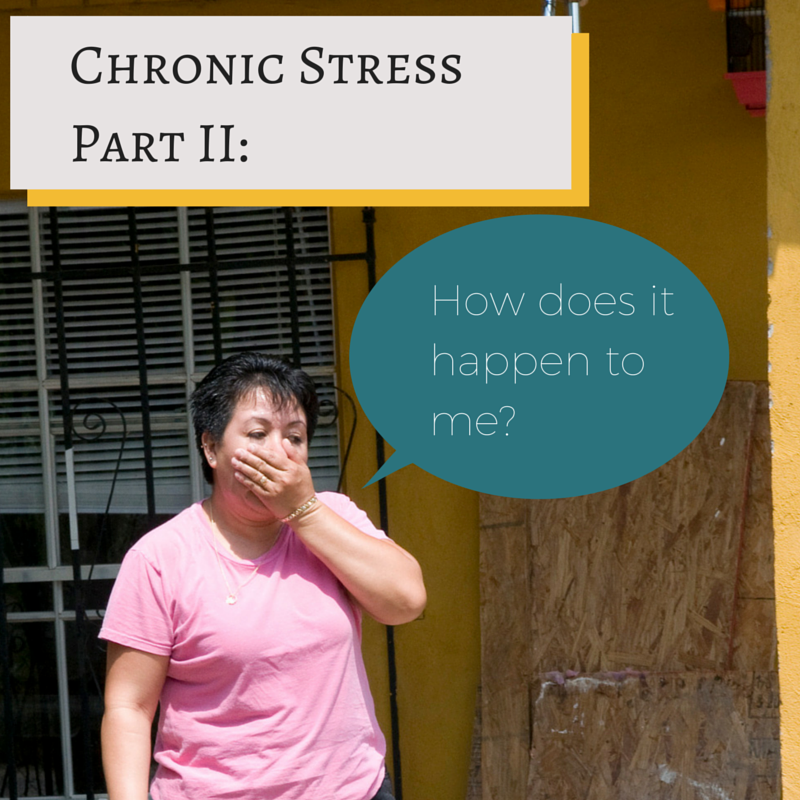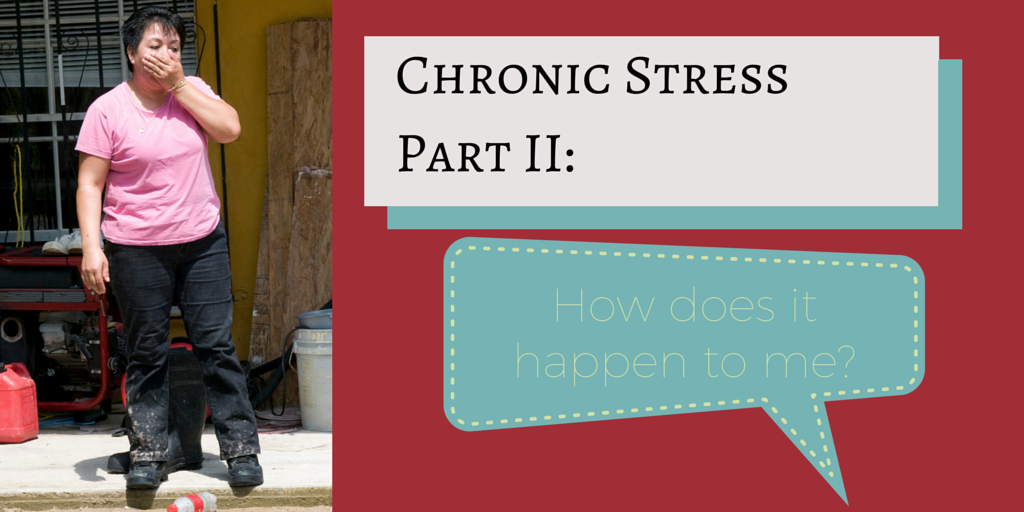
In the last post on Chronic Stress I outlined the symptoms and causes of chronic stress syndrome. I described it as a state represented by two primary features. 1) a constant, ongoing, or routine compromise of function and 2) frequently being brought into a stress state by challenges that should be easily met.
I also explained that the state can brought on by three possible factors: 1) a challenge with an intensity that requires a significant period of recovery, 2) a challenge that requires an extended period of adaptation, or 3) a challenge that occurs with a frequency that doesn’t allow for recovery before being re-introduced.
In all cases, it is the compromise brought on by the stress that inhibits the body’s ability to easily return to an optimal state. For this reason, the chronic stress state leads to the degeneration of the function of your body. In this post I will be outlining some examples taken from common occurrences in daily life to illustrate the onset of chronic stress syndrome.
The first cause of chronic stress is a challenge of great intensity, causing a significant and rapid compromise to the system. This challenge usually requires an extended period of restoration, like after an injury. For example, in a car accident, the impacts involved create significant trauma to the bones, organs, and other tissues. The challenge is very short in duration, like an impact less than a second long. However, the period of time before stabilization, depending on the significance of the injuries, may be hours. The failure of the cells ability to meet the demands of the event leads to significant damage and the restoration requires a significant amount of energy. This restorative process is so tremendous it may be a substantial source of stress in itself. This may lead to the body creating chronically elevated levels of cortisol, wasting of muscle and other tissues, and a compromised state of systemic function. As the restoration becomes less energy expensive, the weakened state of the body and ongoing recovery can last weeks or even months. During this time, tasks that used to be common, such as getting around, up and down stairs, digesting food, and sleeping through the night will cause a stress response. Even cognitive function and memory may be significantly impaired.
The second aspect of a challenge that brings on a chronic stress state is the duration. A challenge which is moderate but long-lasting can lead to the degeneration of the organism in a similar way. This is the case of extended caloric deficit. Famine is an environmental stressor, however dieting is often a self imposed stressor of the same sort. When the available energy is below the bodies ability to easily provide for the common actions in life, a stress response will be the result. If the calories consumed are not sufficient to replenish the body’s energy stores then cortisol will remain elevated, only dropping slightly around meals. The most immediate effect of this sort of chronic stress will be the interruption of sleep due to the fact that cortisol is a wakeful hormone. As energy reserves are low once asleep, it is only a mater of time before the stores run so low that adrenaline is necessary to motivate the release of energy, further exasperating the problem.
Finally, the feature which is the ultimate mark of all chronic stress states is when the frequency is such that the body has not recuperated fully before encountering the next stressful challenge. While this is the case with respect to both of the above scenarios, it is also the case that a frequent recurring challenge of moderate intensity and duration can lead to the degenerative chronic stress state. This is commonly the case in individuals whom are not applying their workouts in an appropriate manner. Each time someone goes for a run or hits the gym, the stress response occurs. This stress response is what drives the development of the system to become more capable of meeting the same physical challenge in the future, and thus become more physically fit. However, if the workouts are repeated without enough time to rest, then the next workout will find the body in a state of reduced ability and will easily lead to degeneration.
So think of the above when considering the individual who decides it’s time to get back in shape. After a extended period of low activity and high stress resulting in degenerated health, he wakes up early one morning, pulls out his old and nearly unused running shoes, and decides to run around the park for an hour before work. This individual has brought an intensity and duration to his activity which will be stressful. He has done so in an already compromised state due to the lack of available energy after fasting through the night and before breakfast. Added to this is the fact that the typical pattern when someone has dedicated themselves to a new regimen of jogging is to wake up the next morning and do it all over again. I have just described a common activity brought on by the desire to become more healthy. When you understand the concept of chronic stress and its degenerative effects it is obvious this activity is likely to cause more harm than benefit.
When any one of these sorts of challenges has engaged the chronic stress state, then the body is even more vulnerable to the other two paths of onset. If the body has accumulated significant enough degeneration from the effects of stress, then the tissues will be more vulnerable to injury, less capable of recovery, and quicker to fail under the basic challenges of life. This is the reason for the statistic effecting individuals over the age of 50 regarding femur and pelvic fractures(1). An injury of this magnitude will often lead to the rapid degeneration and death of the recipient when they are in the fragile condition commonly associated with old age. It is not the case that the age of the individual injured is effecting their ability to recover but the state of their body’s function. In future posts I will describe in more detail how artifacts of degenerative development will result in a decreased functional state. This cumulative effect of stressful encounters is why older individuals are statistically more fragile. This is also why some people are more resilient in their old age than others of a younger age, because their body has not acquired as much degenerative stress.
However, while the above examples show physical causes of stress on the body, a chronic stress state can just as easily be caused by emotional or mental challenges as physical ones. For this reason it is important that physical, nutritional, and social environments are coordinated to allow for overall balance. If you are routinely receiving a stress stimulus at work, then your adrenaline and cortisol levels will be elevated. Engaging in otherwise challenging activities will only exacerbate the problem.
All stress, even the kind that you experience without leaving your chair, can lead to the degeneration of your body’s function if it doesn’t have the energy to cope with it. For this reason the best prevention for chronic stress is to remain well fed and consume high quality foods before or after any planned challenging encounter. This will help reduce the potential lasting harm to your system.
The next post on Stress will be outlining how chronic stressors can culminate the conditions for organ disfunction and eventually disease. This will further elaborate on how the chronic stress state can result in the degeneration and death of an individual even when the cause of death seems unrelated.
(1) Loss of life years after hip fracture: http://www.ncbi.nlm.nih.gov/pubmed/19916683

